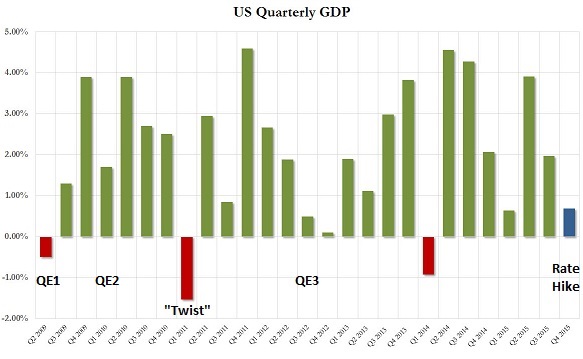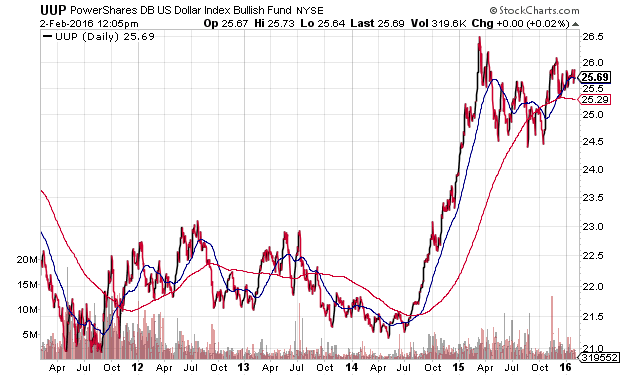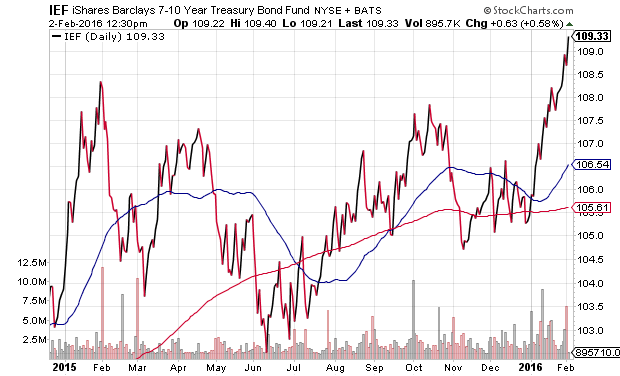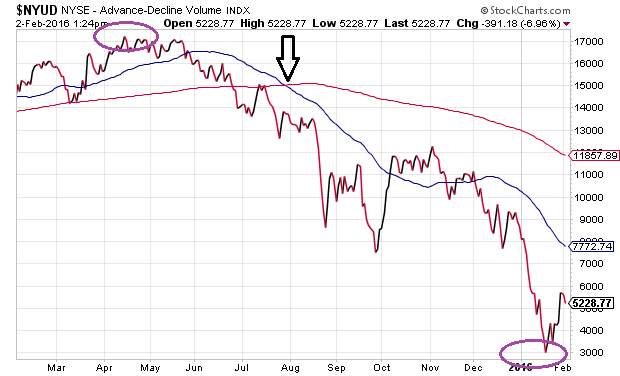The U.S. economy continues to show signs of frailty. U.S. gross domestic product (GDP) expanded at a feeble pace of just 0.7% in the 4th quarter. In the same vein, the Atlanta Fed’s GDP forecast for the first quarter of 2016 is just 1.2%.
There’s more. The manufacturing segment of the economy has contracted for four consecutive months. Meanwhile, year-over-year growth for total business sales as well as retail have steadily eroded. Also, year-over-year activity for corporate spending on tangible assets like equipment, buildings and machinery (i.e. capital goods) has decelerated, ultimately turning negative.

Throughout the course of the current bull market cycle, investors have relied on the Federal Reserve to stimulate the economy as well as risk asset appetite. The central bank of the United States bought mortgage-backed securities and U.S. treasury debt in the beginning of 2009 (a.k.a. “QE1″). When the economy softened in 2010, the Fed rode to the rescue in 2010 with “QE2.” When the euro-zone crisis threatened the world economy in 2011, monetary policy leaders acquired longer-term Treasury securities with the proceeds of shorter-term debt to push borrowing costs even lower. The media dubbed the new stimulus effort, “Operation Twist.” And economic deceleration in 2012 led to the most remarkable stimulus of them all, “QE3.”

What is strange about the picture above? In December of 2015, the Federal Reserve raised its overnight lending rate by 0.25%, even though the U.S. economy had been showing signs of strain. The stimulus removal may not have seemed like a big deal at the time. However, the Fed’s expressed desire to move in the direction of less stimulus has significantly impacted currency exchange rates, corporate bonds, foreign bonds, and investor tolerance for risk.
Consider a few straightforward realities in the ETF world. Since the last bond purchase of QE3 in mid-December of 2014, CurrencyShares Euro Trust (N:FXE) has depreciated 11% and PowerShares US Dollar Bullish (N:UUP) has appreciated 8.5%. Similarly, FXE is near a 5-year low, while UUP is near a 5-year high. CEOs of U.S. corporations regularly cite the super-sized strength of the U.S. greenback as a severe headwind to profit growth.

The directional shift in monetary policy did not simply jolt world currencies. Since the last asset purchase of QE3 in mid-December of 2014, riskier stock assets have lost value. The S&P 500 SPDR Trust (N:SPY) has charted a volatile path toward 6% losses. And that’s the smallest example of wealth destruction. The iShares Core Mid Cap (N:IJH) is off roughly 9%, a small-cap proxy like iShares Russell 2000 (N:IWM) is down 14%, iShares MSCI All-World ex U.S. (N:ACWV) dropped approximately 14%, and Vanguard FTSE Emerging Markets (N:VWO) cratered a starling 23%.

Bear in mind, the limited desire for risk-taking does not stop at the doorstep of the equity markets. Since the last bond purchase of QE3 in mid-December of 2014, long-term treasuries via iShares 20+ Year (N:TLT) is up 5%. Even more impressive? The intermediate area of the yield curve via iShares 7-10 Year Treasury (N:IEF) has tacked on 5% as well; the exchange-traded tracker currently sits at a new 52-week high.

Stock bulls have modified their thesis since the breakdown of market internals in the summer of 2015. Then, there had been great faith in corporate profitability. Today, the earnings picture is decidedly poor, but many are pointing to improving valuations that might support slightly higher price levels. Then, there had been tremendous confidence in the resilience of consumers, particularly in light of energy-related savings. Today, bulls tacitly acknowledge that consumer spending is slowing and that savings has been rising, leading cheerleaders like CNBC’s Jim Cramer to beg the Fed to reconsider its direction on rate guidance.
In a nut shell, bullish investors now hope that the Fed reverses course and discusses stimulus once again. Weaken the dollar. Secure ultra-low borrowing costs. Businesses and consumers can ignore total debt levels if the cost to service those debts abates. And investors? They’ll project lower rates for even longer out into the future, allowing them the luxury to pay premium valuations for stock assets.
That’s the hope, anyway. Cracks in the Fed facade appeared as recently as February 1, when Vice-Chairman Stanley Fischer hinted that fewer rate hikes may be in the cards. It seems probable that the Fed is/was/has always been prone to backtracking.
On the flip side, if the Fed does have a change of heart, will it occur early enough to help the economy and/or inspire investor confidence? Bullish stock investor certainly hope so. Their revised thesis on bear market avoidance depends on it.
That said, central bank policy alone may not be able to keep an economy from succumbing to recessionary forces; it may not stop stocks from falling precipitously. The Federal Reserve did not act early enough or powerfully enough to save stocks from collapsing 50%-plus in the 2000-2002 dot-com disaster, nor was the institution prepared to prevent the 50% shellacking in the 2007-2009 banking crisis.
In truth, monetary policy gamesmanship bolsters asset prices when market internals are improving. Yet the Fed is not omnipotent; its leadership does not have arrows in its collective quill to avert every and any recession. And that means, if the global economy crumbles, it may do more harm than simply act as a drag on the domestic recovery.
Right now, market internals show little evidence of improvement. For instance, over the course of the last 12 months, the New York Stock Exchange Advance/Decline (A/D) Volume Line portrays a very grim picture of risk appetite. Net advancing volume continues to deteriorate as the volume of declining stocks has, more often than not, superseded the volume of advancing issues.

Since the last asset purchase of QE3 in mid-December of 2014, corporate credit tells a similar story about risk preferences. The rising price ratio between investment grade corporate credit via iShares Investment Grade (N:CIU) relative to iShares High Yield Corporate (N:HYG) is near a 52-week high.

Our tactical shift toward lower risk since mid-2015 remains the same. Moderate growth and income investors at Pacific Park Financial, Inc. have approximately 50% in low volatility, high quality U.S. large caps. We have 25% in investment grade bonds, primarily Treasury bonds and munis. The remaining 25% in cash/cash equivalents exists to lessen the volatility while awaiting better buying opportunities in the near future.
Disclosure: Gary Gordon, MS, CFP is the president of Pacific Park Financial, Inc., a Registered Investment Adviser with the SEC. Gary Gordon, Pacific Park Financial, Inc, and/or its clients may hold positions in the ETFs, mutual funds, and/or any investment asset mentioned above. The commentary does not constitute individualized investment advice. The opinions offered herein are not personalized recommendations to buy, sell or hold securities. At times, issuers of exchange-traded products compensate Pacific Park Financial, Inc. or its subsidiaries for advertising at the ETF Expert web site. ETF Expert content is created independently of any advertising relationships.
